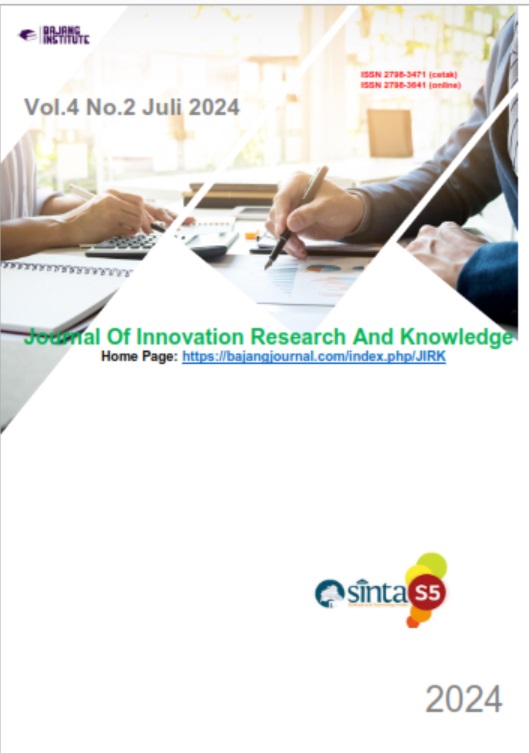HUBUNGAN REGULASI DIRI DENGAN INTENSITAS PENGGUNAAN MEDIA SOSIAL PADA MAHASISWA FAKULTAS PSIKOLOGI UNIVERSITAS KRISTEN SATYA WACANA
DOI:
https://doi.org/10.53625/jirk.v4i2.8075Keywords:
Self-regulation, Intensity of Social Media Use,, Student, Social media.Abstract
The development of information and technology has given rise to social media which has now become part of various levels of society, especially young people such as students. The emergence of social media is accompanied by positive and negative impacts which is lead to an urgency to reduce the intensity of its use, one of which is by setting self-regulation. This research aims to determine the relationship between self-regulation and the intensity of social media use among students at the Faculty of Psychology, Universitas Kristen Satya Wacana. This research is quantitative research, where data collection was carried out by distributing questionnaires to 150 respondents. The correlation test results show that there is a relationship between self-regulation and the intensity of social media use, where the correlation coefficient of 0.273 is positive, indicating the relationship is at a weak level. The results of data categorization show that respondents' self-regulation is in the medium category as much as 56% and in the high category as much as 44%. Meanwhile, the intensity of social media use in the low category was 2%, in the medium category was 86.7%, and in the high category was 11.3%.
References
Awalia, R., Fikrie, & Rifandi, A. (2022). Peranan Regulasi Diri Terhadap Kecenderungan Kecanduan Media Sosial Pada Mahasiswa. Jurnal Psikologi MANDALA, 6(2).
Blair, C., & Raver, C. (2012). Child Development in the Context of Adversity. American Psychologist, 67(4), 309-318. doi: 10.1037/a0027493
Calista, A. B. (2021). Regulasi Diri dengan Intensitas Penggunaan Media Sosial Instagram Pada Remaja. Universitas Muhammadiyah Surakarta, Psikologi. Surakarta: Universitas Muhammadiyah Surakarta.
Cao, X., Ali, A., Pitafi, A., Khan, A., & Waqas, M. (2020). A socio-technical system approach to knowledge creation and team performance: evidence from China. Information Technology & People. doi:https://doi.org/10.1108/ITP-10-2019-0536
Cao, X., Khan, A., Ali, A., & Khan, N. (2019). Consequences of Cyberbullying and Social Overload while Using SNSs: A Study of Users’ Discontinuous Usage Behavior in
SNSs. Information Systems Frontiers. doi:https://doi.org/10.1007/s10796-019-09936-8
Kapoor, K. K., Tamilmani, K., Rana, N., Patil, P., Dwivedi, Y., & Nerur, S. (2018).
Advances in Social Media Research: Past, Present and Future. Inf Syst Front, 20, 531-
doi:https://doi.org/10.1007/s10796-017-9810-y
Koukaras, P., Tjortjis, C., & Rousidis, D. (2019). Social Media Types: introducing a data driven taxonomy. Computing. doi:https://doi.org/10.1007/s00607-019-00739-y
Krishna, S. H., Jayanthi, M., Ghosh, P., Tamrakar, A., Gopinathan, R., & Dagar, P. (2022). A Study on Positive and Negative Effects of Social Media on Society. International
Journal of Early Childhood Special Education, 14(5). doi:10.9756/INTJECSE/V14I5.783
Li, Y. (2018). Upward social comparison and depression in social network settings: The roles of envy and self-efficacy. Internet Research. doi:https://doi.org/10.1108/IntR-09-2017-0358
Mansi, G., & Levy, Y. (2013). Do instant messaging interruptions help or hinder knowledge workers’ task performance? International Journal of Information Management, 33, 591-596. doi:10.1016/j.ijinfomgt.2013.01.011
McClelland, M., Geldhof, J., Morrison, F., Gestsdóttir, S., Cameron, C., Duckworth, A., . . .Grammer, J. (2018). Self-Regulation. In N. Halfon, C. Forrest, R. Lerner, & E. Faustman, Handbook of Life Course Health Development. Springer. doi:10.1007/978-3-319-47143-3
Ozimek, P., & Förster, J. (2021). The Social Online-Self- Regulation-Theory: A Review of Self-Regulation in Social Media. Journal of Media Psychology, 33(4), 181-190.
doi:https://doi.org/10.1027/1864-1105/a000304
Primack, B. A., & Escobar-Viera, C. (2017). Social media as it interfaces with psychosocial development and mental illness in transitional age youth. Child Adolescent
Psychiatric Clinics of North America, 26, 217-233. doi:http://dx.doi.org/10.1016/j.chc.2016.12.007
Puspita, A. (2022). Hubungan Regulasi Diri Terhadap Intensitas Penggunaan Media Sosial Pada Remaja di Bangka Belitung. Skripsi. Universitas Mercu Buana Yogyakarta.
Sahranç, Ü., & Duç-Urhan, E. (2021). A Study on the Relationship Between Social Media Addiction and Self-Regulation Processes among University Students. International Journal of Psychology and Educational Studies, 8(4), 96-109. doi:https://dx.doi.org/10.52380/ijpes.2021.8.4.546
Syarief, B. A., & Genoveva. (2015). The Analysis of Communication between Friends on Social Media towards Purchase Intension (A Study Case of Companies in
Entrepreneurship Project of President University, Bekasi, Indonesia). Procedia -Social and Behavioral Sciences, 169, 31-42. doi:https://doi.org/10.1016/j.sbspro.2015.01.283
Twenge, J. M., Joiner, T., Rogers, M., & Martin, G. (2017). Increases in Depressive Symptoms, Suicide-Related Outcomes, and Suicide Rates Among U.S. Adolescents After 2010 and Links to Increased New Media Screen Time. Clinical Psychological
Science, 1-15. doi:https://doi.org/10.1177/2167702617723376
Van den Eijnden, R., Koning, I., Doornwaard, S., van Gurp, F., & Ter Bogt, T. (2018). The impact of heavy and disordered use of games and social media on adolescents’ psychological, social, and school functioning. Journal of Behavioral Addictions, 7(3), 697-706. doi:https://doi.org/10.1556/2006.7.2018.65
Vannice, J., & Losoff, R. (n.d.). Self-Regulation. In J. Kreutzer, J. DeLuca, & B. Caplan, Encyclopedia of Clinical Neuropsychology. Springer. doi:https://doi.org/10.1007/978-3-319-56782-2_1490-2
Vitak, J., Ellison, N., & Steinfield, C. (2011). The Ties That Bond: Re-Examining the Relationship between Facebook Use and Bonding Social Capital. Proceedings of the 44th Hawaii International Conference on System Sciences. doi:http://dx.doi.org/10.1109/HICSS.2011.435
Vohs, K. D., & Baumeister, R. (2016). Handbook of Self-Regulation: Research, Theory, and Applications, Third Edition. . New York: Guilford.
Wanless, S. B., McClelland, M., Tominey, S., & Acock, A. (2011). The Influence of Demographic Risk Factors on Children's Behavioral Regulation in Prekindergarten and Kindergarten. Early Education and Development, 22(3), 461-488.
doi:10.1080/10409289.2011.536132
We Are Social, Hootsuite. (2021). Indonesia Digital Report 2021. Wirtz, B. W., Göttel, V., & Daiser, P. (2017). Social Networks: Usage Intensity and Effects on Personalized Advertising. Journal of Electronic Commerce Research,, 18(2).
Zelazo, P. D., Blair, C., & Willoughby, M. (2016). Executive Function: Implications for Education. Washington, DC: National Center for Education Research, Institute of Education Sciences, U.S. Department of Education.
Zimmerman, B. J. (2012). Development and Adaptation of Expertise: The Role of Self-
Regulatory Processes and Beliefs. In A. K. Ericsson, N. Charness, P. Feltovich, & R.
Hoffman, The Cambridge Handbook of Expertise and Expert Performance. New
York: Cambridge University Press.













